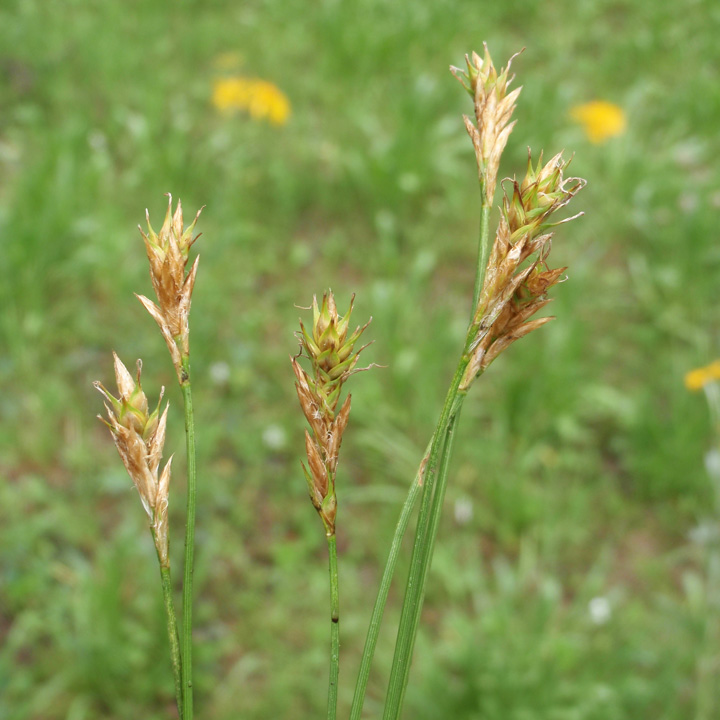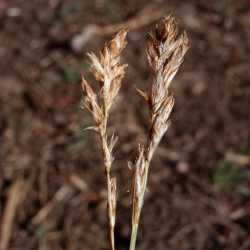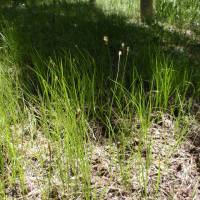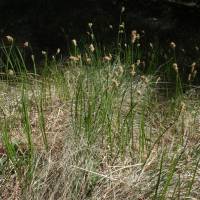Culms trigonous, 15-90 cm, scabrous-angled. Leaves: sheath with apex of inner band hyaline, not or barely thickened, concave; ligules 0.7-2.5 mm; blades 1-3.2 mm wide. Inflorescences 1-5 cm; spikes 4-12, ascending, ovate; proximal spikes pistillate; middle spikes often staminate; terminal spike pistillate or androgynous. Pistillate scales reddish brown with green center and hyaline margins, ovate, 2.8-5.5 mm, shorter than to equaling perigynia, apex acute to acuminate. Perigynia thin-margined, wingless, lanceolate to ovate, 3.9-6.5 × 1.4-2.4 mm; beak 1.2-2.7 mm. 2n = 70.
Fruiting May-Jul. Open, sandy oak, oak-pine, or pine forests and savannas, dry prairies, sand dunes, sandy fields, sunny rock outcrops, alpine or subalpine meadows; 0-3600 m; Alta., B.C., Man., N.W.T., Ont., Que., Sask., Yukon; Ariz., Colo., Conn., Ill., Ind., Maine, Mass., Mich., Minn., N.H., N.J., N.Mex., N.Y., Ohio, Pa., R.I., S.Dak., Utah, Vt., Wash., Wis., Wyo.
Though most frequently smooth adaxially and more or less distinctly veined, the perigynia of Carex siccata are quite variable in venation and surface texture. Throughout the range of the species, plants with perigynia veinless or, essentially so, occur occasionally. Those plants have been designated as C. foenea var. enervis Evans & Mohlenbrock. Less commonly, the perigynia are tuberculate adaxially. Such plants have been designated as C. foenea var. tuberculata F. J. Hermann and specimens have been seen from Washington, Colorado, Arizona, and Wisconsin, and reported from Alberta and New Mexico. They probably occur sporadically throughout the range. Rarely, plants are both veinless and tuberculate.
Carex siccata is a very common species of open pinelands in portions of its western range; it becomes very local in much of the easternmost portions of its range.
The name Carex foenea has, unfortunately, commonly been misapplied to the species in some recent literature.
Infrequent in the lake area in dry open sandy soil and in open black oak woods.
Common Name: dryspike sedge
Duration: Perennial
Nativity: Native
Lifeform: Graminoid
General: Trigonous stems arising from creeping rhizomes, light to medium brown, stems solitary or 2-3 in a cluster, 15-90 cm tall, scabrous angled.
Vegetative: Leaves erect or ascending, exceeded by spikes and stems, not forming a basal cluster, flat, 1.5-3 mm wide, sheath with hyaline apex, not or barely thickened, concave.
Inflorescence: Spikes 4-12 per stems, borne in ascending ovate to oblong head at summit of stem, sessile, 1.5-3.5 cm long and 1 cm wide, inconspicuously bracteate, lowest spikes pistillate, middle staminate and terminal spike pistillate or androgynous; pistillate scales reddish brown with green center and hyaline margins, ovate, 2.8-5.5 mm, shorter than or equaling perigynia, apex acute to acuminate; perigynia thin margined, strongly nerved, wingless, lanceolate to ovate, 4-6.5 mm long by 1.4-2.4 mm wide, abruptly tapering into a beak 1.2-3 mm long.
Ecology: Found in open to thinly wooded sites, on dry to moderately moist soils from 7,000-11,000 ft (2134-3353 m); flowers June-July.
Notes: This is a common sedge of moderately moist to dry habitats, and it is strongly rhizomatous, often forming sparse turf in forests and meadows. Immature inflorescences are often confused with Carex praegracilis, C. occidentalis, and C. vallicola, all being slight but moderately elongate. All of these species are androgynous, but Carex praegracilis more usually has predominantly unisexual inflorescences, and darker rhizomatous bases. Both Carex occidentalis and C. vallicola are more commonly clumping, though C. occidentalis sometimes displays a short-rhizomatous habit. Carex siccata can usually be distinguished from these two however (even at an early stage), by having some predominantly male spikes in the middle of the inflorescence, and the majority of the pistillate flowers in the terminal spike and secondarily in the lowest spike. This pattern can have a fair bit of variation, but usually is less regular in the male/female relationship than the others. Carex foena has been misapplied to this taxon in Arizona; it is a northeastern sedge in the Ovales section, and does not occur in Arizona. (Notes: Max Licher and Glenn Rink 2012)
Ethnobotany: Unknown
Etymology: Carex is the classical Latin name for the genus, while siccata possibly comes from Latin siccare for drying or to dry out.
Synonyms: Carex foenea var. enervis, Carex foenea var. tuberculata
Editor: SBuckley, 2010
Stems 1.5-4(-6) dm, scattered on tough brown rhizomes, distinctly aphyllopodic; lvs ±flat, (1-)1.5-3 mm wide, generally all on the lower fourth of the stem; sheaths thin- hyaline ventrally; spikes mostly 4-12, sessile, ca 1 cm or less, inconspicuously bracteate, aggregated into a cylindric or clavate-cylindric infl 1.5-3.5 cm, mostly androgynous, but the lower often largely or wholly staminate, and the uppermost one sometimes wholly pistillate and closely subtended by one or more very short staminate spikes so as to appear gynaecandrous; perigynia generally conspicuously surpassing the scales, lance-ovate to ±elliptic, planoconvex, sharp-edged proximally, becoming thin-margined distally, evidently about 10-nerved dorsally, evidently to obscurely few-nerved ventrally, 4.5-6.2 mm including the prominent beak that is more than half as long as the body; achene lenticular; 2n=70. Dry, sterile or sandy soil, in open places in light shade; Me. to Mack., s. to N.J., O., Ill., Minn., and Ariz. (C. foenea, misapplied)
Gleason, Henry A. & Cronquist, Arthur J. 1991. Manual of vascular plants of northeastern United States and adjacent Canada. lxxv + 910 pp.
©The New York Botanical Garden. All rights reserved. Used by permission.











